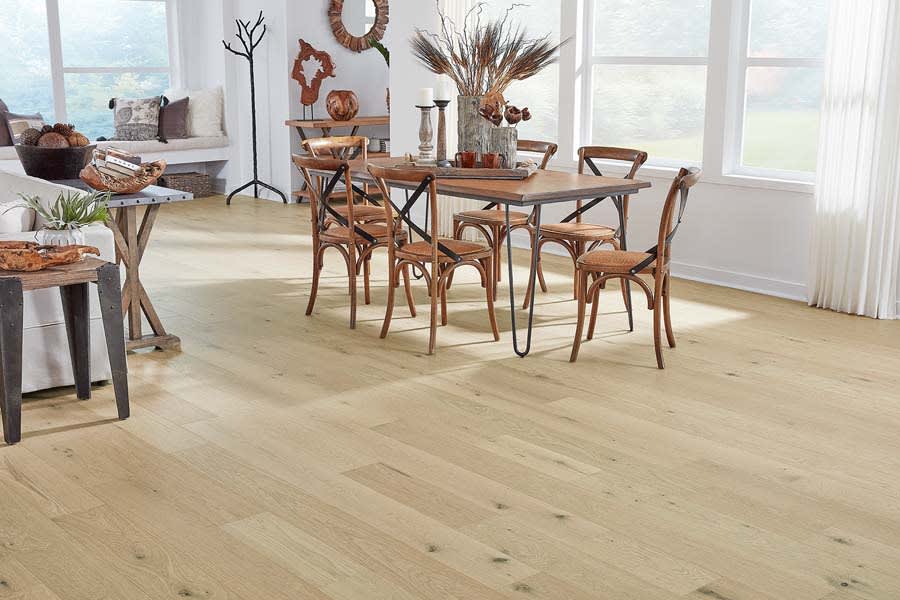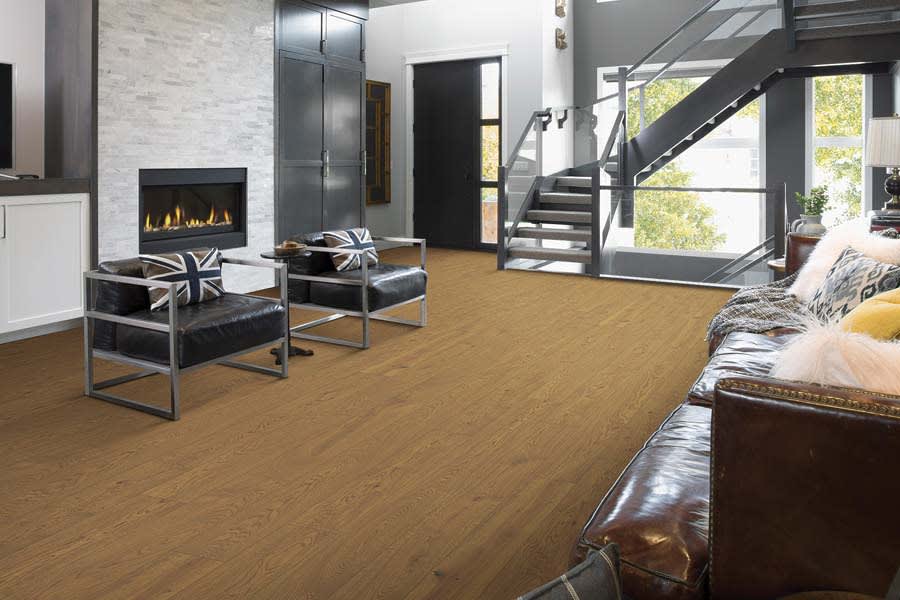About hardwood flooring
Elegant, durable and stylish, new hardwood floors are an excellent choice for your home. Not only are they affordable and cost-effective — adding to your home’s overall value — but they are also harvested from a sustainable resource, healthy for your home’s air quality and your family’s well-being and easy to maintain with regular cleaning. Your solid hardwood floors are a lifetime product — once you have installed them, they will be with you for the long-haul. They also fit perfectly into any home design, from contemporary to rustic to traditional. Our stunning natural wood flooring is a fantastic option for giving your home a classic look that will last for years.
Some hardwood is waterproof, providing protection against spills and wet traffic.
Hardwood are designed to hold up to the demands of traffic, resisting scratch and dents.
Some hardwood is waterproof, providing protection against spills and wet traffic.
Hardwood are designed to hold up to the demands of traffic, resisting scratch and dents.
Why choose natural hardwood?
Solid hardwood flooring is all-natural and made entirely of timber from traditional and exotic materials like red oak, maple, walnut, cherry, bamboo and more. In addition to the variety of materials, natural wood flooring comes in a plethora of finishes, colors, sizes and styles.
Types of hardwood:
Engineered hardwood
Solid hardwood
Floating hardwood
Types of hardwood:
Engineered hardwood
- Constructed from several layers of wood pressed together.
- Less susceptible to moisture damage because of its multi-ply construction.
- Versatile
- Less expensive than solid hardwood.
Solid hardwood
- Consists of solid pieces of wood from preferred species,
- Extremely durable.
- Susceptible to moisture damage.
Floating hardwood
- Multiple thinly layers glued together.
- Inner core layers of hardwood or birch plywood material.
- Most can be stapled/glued over a wood or concrete subfloor
Request an estimate
Engineered vs. solid hardwood
Both engineered and solid hardwoods are viable options for flooring — not to mention sought-after materials on the market. The process to transform hardwood trees into beautiful, functional flooring is different for engineered and solid hardwood, but each has its advantages.
When you hear “engineered,” you might think it’s fake wood. While there is manufacturing involved, the process starts with authentic wood. The real wood is separated into thin pieces, then layered in a crisscrossing pattern to form a durable core. An adhesive keeps these layers together, and it’s typically finished off with a sturdy wooden top and bottom layer surrounding the core.
Because engineered wood floors expand and contract less than solids, they are ideal for any level, including basement installations. Engineered hardwood has the same appearance as solid hardwood styles once it’s finished.
Solid hardwood comes in straightforward cuts without any structural divisions or bonding. After undergoing a few shaping and smoothing steps, tongues and grooves are added to the planks so they can closely fit together during installation. A coating for safeguarding the wood covers the surfaces, too.
Since solid hardwood is fairly thick, it can be periodically sanded for refinishing, and it’s a go-to option for endurance. While engineered flooring usually can be sanded & refinished, it cannot always be done as many times as solid wood flooring. Solid hardwood shouldn’t be part of below-ground rooms, but it can still resist moisture with an underlying foundation.
When you hear “engineered,” you might think it’s fake wood. While there is manufacturing involved, the process starts with authentic wood. The real wood is separated into thin pieces, then layered in a crisscrossing pattern to form a durable core. An adhesive keeps these layers together, and it’s typically finished off with a sturdy wooden top and bottom layer surrounding the core.
Because engineered wood floors expand and contract less than solids, they are ideal for any level, including basement installations. Engineered hardwood has the same appearance as solid hardwood styles once it’s finished.
Solid hardwood comes in straightforward cuts without any structural divisions or bonding. After undergoing a few shaping and smoothing steps, tongues and grooves are added to the planks so they can closely fit together during installation. A coating for safeguarding the wood covers the surfaces, too.
Since solid hardwood is fairly thick, it can be periodically sanded for refinishing, and it’s a go-to option for endurance. While engineered flooring usually can be sanded & refinished, it cannot always be done as many times as solid wood flooring. Solid hardwood shouldn’t be part of below-ground rooms, but it can still resist moisture with an underlying foundation.
What is hand scraped flooring?
Hand scraped wood is a popular rustic flooring material that takes the natural, luxurious beauty of solid hardwood and transforms it into something modern and unique. The wood planks of this flooring type have undergone the hand scraping process, where an artisan treats them with various tools to give them a worn, distressed appearance.
With its vibrant colors and versatile design, you can customize hand scraped wood flooring to accommodate any style, but it’s most suitable for rustic farmhouse homes. If you’re looking for solid or engineered hardwood floors for your rural home, explore the characteristics and benefits of durable, aesthetically pleasing hand scraped hardwood. For a fresh combination of traditional and modern, these newly cut wood planks will give your home the look of a preserved historic home.
Manufacturers can hand scrape any wood species, but some take to the various scraping tools better than others. Soft woods, such as oak, pine and walnut, can withstand the hand scraping process, while teak and maple are hard woods. If you use a wood that’s challenging to scrape, the result isn’t always aesthetically pleasing.
As you choose a wood species to create your hand scraped hardwood flooring, think about your home’s color scheme and the durability you need for the floors in your room. You could also get engineered wood, which contains multiple fibers of wood to create a single plank.
If you have decided on hardwood floors, the width of each plank is not just another decision on your checklist. It is one of the key style options you have and selecting floor plank size will have a dramatic effect on the final look in your home.
It’s not as simple as the difference between wide or narrow plank flooring. Floor width affects style, look and how appropriate your floors are for your décor. You may wish to start by considering the style and feel you want. Here are some tips for picking floor plank size:
With its vibrant colors and versatile design, you can customize hand scraped wood flooring to accommodate any style, but it’s most suitable for rustic farmhouse homes. If you’re looking for solid or engineered hardwood floors for your rural home, explore the characteristics and benefits of durable, aesthetically pleasing hand scraped hardwood. For a fresh combination of traditional and modern, these newly cut wood planks will give your home the look of a preserved historic home.
Manufacturers can hand scrape any wood species, but some take to the various scraping tools better than others. Soft woods, such as oak, pine and walnut, can withstand the hand scraping process, while teak and maple are hard woods. If you use a wood that’s challenging to scrape, the result isn’t always aesthetically pleasing.
As you choose a wood species to create your hand scraped hardwood flooring, think about your home’s color scheme and the durability you need for the floors in your room. You could also get engineered wood, which contains multiple fibers of wood to create a single plank.
Choosing hardwood flooring width
If you have decided on hardwood floors, the width of each plank is not just another decision on your checklist. It is one of the key style options you have and selecting floor plank size will have a dramatic effect on the final look in your home.
It’s not as simple as the difference between wide or narrow plank flooring. Floor width affects style, look and how appropriate your floors are for your décor. You may wish to start by considering the style and feel you want. Here are some tips for picking floor plank size:
- Go thinner for an elegant look: A refined look often works best with slender 2 ¼-inch widths.
- Try wide for a rustic feel: Wider boards of at least 5 inches in width will look the most rustic and are most appropriate if you’re also looking for a weathered, bleached or distressed wood look.
- Stick with thin widths for a classic wood floor: If you’re a traditionalist, planks between 2 ¼ inches and 3 inches are most common in homes and give you that classic hardwood floor appearance.
- Go wide if you love character: Wider floorboards of 5 to 12 inches reveal a wood’s character, including grain and knots. If you love to highlight the uniqueness of wood, wider boards are an option. If you want a more uniform look with fewer unique characteristics, narrow boards may be right for you.
- Go wide if you love contemporary looks and modern trends: Modern designers love wide floorboards and widths of 10 inches or even more are not uncommon. This is a very versatile look that works with modern décor but also looks current with traditional or historic homes.
- Try wide widths if you want fewer seams: Some designers love the look of many seams, which means narrow floorboards are ideal. If you prefer a uniform look where seams are not visible, choose wider widths.
- If you’re hoping for a herringbone pattern: Thinner boards will work best with a pattern and will give you the most flexibility to line up corners correctly.
- When mixing and matching different widths and sizes of planks: If you want to mix and match for effect, wider planks work with the eclectic look best.
- When considering your budget: Narrower hardwood boards tend to be less costly when compared with the wider styles. If budget is a concern, 50 Floor may be able to help. With a price match guarantee and low prices on quality manufacturers, 50 Floor helps you enjoy a beautiful floor at a very competitive price.
- Overall dimensions room dimensions: Large rooms look great with wide planks. If you want to make a small room look larger, you can do so with narrow boards. You can also create a dramatic look by choosing wider boards for smaller rooms.












